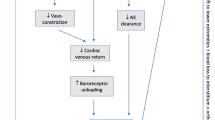Opinion statement
Movement disorder emergencies occur in both hypokinetic and hyperkinetic patients. Prompt recognition of these emergencies is crucial, and diagnosis is based on history and phenomenology. Supportive and temporizing measures must be implemented immediately before disease-specific therapy is begun. For neuroleptic malignant syndrome and related conditions, we recommend a three-tier approach depending on severity, starting with benzodiazepines, dopamine agonists or levodopa, and dantrolene or electroconvulsive therapy. Methylprednisolone pulse therapy also is beneficial for neuroleptic malignant syndrome due to abrupt medication withdrawal in patients with Parkinson’s disease. In treatment of other acute antidopaminergic-induced emergencies, anticholinergics usually suffice. To manage airway obstruction related to movement disorders, we rely on laryngoscopic evaluation to determine whether noninvasive or invasive interventions are needed. Hyperkinetic emergencies are treated individually based on the type of abnormal movements. If an antidopaminergic is needed, we prefer a dopamine depletor to a dopamine receptor blocker because of the risk of tardive syndromes with the latter. When focal hyperkinetic movements dominate the picture, botulinum toxin injection is a useful adjunct to medications.
Similar content being viewed by others
References and Recommended Reading
Movement Disorder Emergency: Diagnosis and Treatment. Edited by Frucht SJ, Fahn S. Totowa, NJ: Humana Press; 2005.
Caroff SN, Mann SC, Campbell EC: Neuroleptic malignant syndrome. Adverse Drug React Bull 2001, 209:799–802.
Gibb WR, Griffith DN: Levodopa withdrawal syndrome identical to neuroleptic malignant syndrome. Postgrad Med J 1986, 62:59–60.
Rosenberg MR, Green M: Neuroleptic malignant syndrome: review of response to therapy. Arch Intern Med 1989, 149:1927–1931.
Sato Y, Asoh T, Metoki N, Satoh K: Efficacy of methylprednisolone pulse therapy on neuroleptic malignant syndrome in Parkinson’s disease. J Neurol Neurosurg Psychiatry 2004, 75:510–515.
Trollor JN, Sachdev PS: Electroconvulsive treatment of neuroleptic malignant syndrome: a review and report of cases. Aust N Z J Psychiatry 1999, 33:650–659.
Fahn S, Greene PE, Ford B, Bressman SB: Handbook of Movement Disorders. Philadelphia: Current Medicine Inc.; 1997.
Miodownik C, Lerner V, Statsenko N, et al.: Vitamin B6 versus mianserin and placebo in acute neuroleptic-induced akathisia: a randomized, double-blind, controlled study. Clin Neuropharmacol 2006, 29:68–72.
Poyurovsky M, Pashinian A, Weizman R, et al.: Low-dose mirtazapine: a new option in the treatment of antipsychotic-induced akathisia. A randomized, double-blind, placebo-and propranolol-controlled trial. Biol Psychiatry 2006, 59:1071–1077.
Fahn S: The tardive dyskinesias. In Recent Advances in Clinical Neurology, vol 4. Edited by Matthews WB, Glaser GH. Edinburgh: Churchill Livingstone; 1984:229–260.
Isozaki E, Naito A, Horiguchi S, et al.: Early diagnosis and stage classification of vocal cord abductor paralysis in patients with multiple system atrophy. J Neurol Neurosurg Psychiatry 1996, 60:399–402.
Grillone GA, Blitzer A, Brin MF, et al.: Treatment of adductor laryngeal breathing dystonia with botulinum toxin type A. Laryngoscope 1994, 104:30–32.
Postuma RB, Lang AE: Hemiballism: revisiting a classic disorder. Lancet Neurol 2003, 2:661–668.
Grandas F: Ballism. In Parkinson’s Disease and Other Movement Disorders. Edited by Jankovic J, Tolosa E. Philadelphia: Lippincott Williams & Wilkins; 2002:234–239.
Manji H, Howard RS, Miller D, et al.: Status dystonicus; the syndrome and its management. Brain 1998, 121:243–252.
Hinson VK, Goetz CG: Tic emergencies. In Movement Disorder Emergency: Diagnosis and Treatment. Edited by Frucht SJ, Fahn S. Totowa, NJ: Humana Press; 2005:157–165.
Marras C, Andrews D, Sime E, Lang AE: Botulinum toxin for simple motor tics: a randomized, double-blind, controlled clinical trial. Neurology 2001, 56:605–610.
Kwak C, Hanna P, Jankovic J: Botulinum toxin in the treatment of tics. Arch Neurol 2000, 57:1190–1193.
Schneider SA, Aqqarwal A, Bhatt M, et al.: Severe tongue protrusion dystonia: clinical syndrome and possible treatment. Neurology 2006, 67:940–943.
Nirenberg MJ, Frucht SJ: Myoclonus. Curr Treat Options Neurol 2005, 7:221–230.
Frucht SJ, Houghton WC, Bordelon Y, et al.: A single-blind, open-label trial of sodium oxybate for myoclonus and essential tremor. Neurology 2005, 65:1967–1970.
Bakker MJ, van Dijk JG, van den Maagdenberg AM, Tijssen MA: Startle syndromes. Lancet Neurol 2006, 5:513–524.
Tijssen MA, Schoemaker HC, Edelbroek PJ, et al.: The effects of clonazepam and vigabatrin in hyperekplexia. J Neurol Sci 1997, 149:63–67.
Author information
Authors and Affiliations
Corresponding author
Rights and permissions
About this article
Cite this article
Hu, SC., Frucht, S.J. Emergency treatment of movement disorders. Curr Treat Options Neurol 9, 103–114 (2007). https://doi.org/10.1007/s11940-007-0036-z
Published:
Issue Date:
DOI: https://doi.org/10.1007/s11940-007-0036-z




